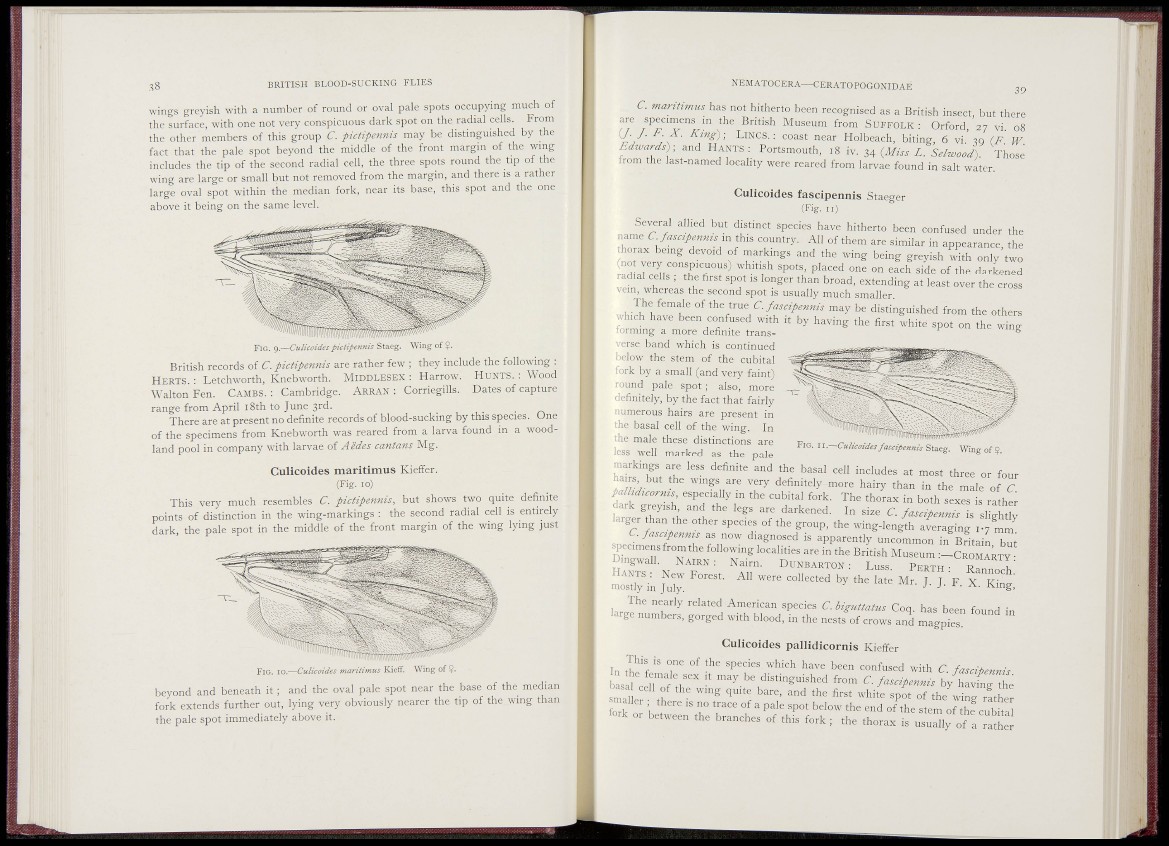
38 BRITISH BLOOD-SUCKING FLIES
wings greyish with a number of round or oval pale spots occupying much of
the surface, with one not very conspicuous dark spot on the radial cells. From
the other members of this group C. picHpennis may be distinguished by the
fact that the pale spot beyond the middle of the front margin of the wmg
includes the tip of the second radial cell, the three spots round the tip of the
wing are large or small but not removed from the margin, and there is a rather
large oval spot within the median fork, near its base, this spot and the one
above it being on the same level.
FIG. 9.—CulicoidespicUpennis fataeg. Wing of
British records of C. pictipennis are rather few ; they include the following :
HERTS. : Letchworth, Knebworth. MIDDLESEX : Harrow. HUNTS. : Wood
Walton Fen. CAMBS. : Cambridge. ARRAN : Corriegills. Dates of capture
range from Apri l i8th to June 3rd.
There are at present no definite records of blood-sucking by this species. One
of the specimens from Knebworth was reared from a larva found in a woodland
pool in company with larvae of Aedes cantans Mg.
Culicoides maritimus Kieffer.
(Fig. 10)
This very much resembles C. pictipennis, but shows two quite definite
points of distinction in the wing-markings : the second radial cell is entirely
dark, the pale spot in the middle of the front margin of the wing lying just
FIG. 10.—Culicoides maritimus Kieff. Wing of
beyond and beneath it ; and the oval pale spot near the base of the median
fork extends further out, lying very obviously nearer the tip of the wing than
the pale spot immediately above it.
N E M A T O C E R A — C E R A T O P O G O N I D A E
maritimus has not hitherto been recognised as a British insect, but there
are specimens in the British Museum from SUFFOLK : Orford, 27 vi 08
^i/' J Holbe a ch, biting, 6 vi 30 (F W
Edwards) , and HANTS : Portsmouth, 18 iv. 34 {M^ss L. Selwood). Those
from the last-named locality were reared from larvae found in salt wicr.
Culicoides fascipennis Staeger
(Fig. II)
Several allied but distinct species have hitherto been confused under the
name C fasc^penn^s .n^_U. country. All of them are similar in appearance, the
.horax being devoid rf markings and the wing being greyish with only two
S ' ' T ' ^^^^ ^^^^ ^he darkened
radial cells , the first spot is longer than broad, extendmg at least over the cross
vein, whereas the second spot is usually much smaller
The female of the true C.fasc^penn^s may be distinguished from the others
which have been confused with it by having the first white spot on the wing
forming a more definite trans- ^
verse band which is continued
below the stem of the cubital
fork by a small (and very faint)
round pale spot ; also, more
definitely, by the fact that fairly
numerous hairs are present in
the basal cell of the wing. In
the male these distinctions are
FIG. 11—Culicoides fascipennis Stiieg. Wing of
less well marked as the pale
markings are less definite and the basal cell includes at most three or four
hairs but the wings are very definitely more hairy than in the male o 7
Palhduorms especially in the cubital fork. The thorax in both sexes is ratht;
larger than the other species of the group, the wing-length aLa g i n g 1-7 „ m
C fasapenms as now diagnosed is apparently uncommon in Britain bui
specimens from the following localities are in the British Museum :-CROMARTY
Dingwall. NAIRN: Nairn. DUNBARTON : Luss PERTH- I"
HANTS : New Forest. All were collected by the late ^ T ) F X
mostly in July. j- j. r. J<ving,
The nearly related American species C.biguttatus Coq. has been found in
large numbers, gorged with blood, in the nests of crows and magpies
Culicoides pallidicornis Kieffer
In '' wi th C fascitennis
•.iiri. •